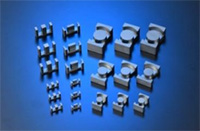Hitachi Metals Creates New Soft Ferrite Core Material
Offering Outstanding Temperature Properties
for Automobile Components
April 11, 2016
Hitachi Metals, Ltd.
Hitachi Metals, Ltd. is pleased to announce the successful development of ML29D, an innovative soft ferrite core material for automobile components that offers outstanding low-loss properties usable in a wide range of temperature environments. Not only is ML29D expected to significantly improve the efficiency and reliability of transformers, inductors and other electronic components used in automotive applications, it will also minimize their size and weight. A mass production system for this new material is already in place.
1.Background
Hitachi Metals produces and sells soft ferrite, one of several soft magnetic materials used to make electrical circuits for automobile electronic components and other products. The company has earned stellar evaluations for the stable quality of its core materials, which are favored by a growing number of customers.
The intensifying trend of incorporating electronic technology in automobiles has spurred growing demands for higher efficiency and reliability in such electronic components. Requests for more compact components have also prompted the development of smaller, lighter versions of these densely packed units. Since these components are often used in proximity to engine compartments, another key requirement is the ability to deliver higher performance and reliability throughout a broad range of temperature environments.
The core materials used in transformers, inductors and other automotive components generally experience core loss*1. This type of loss ultimately produces heat, which raises the temperature in the immediate vicinity. Because heat increases pose a threat to the reliability of electronic components, there are mounting demands for core materials that ensure lower core loss in high-temperature environments.
2.Outline

Created from a manganese-zinc (Mn-Zn) ferrite material possessing low-loss properties in a wide range of temperature environments, ML29D is a soft ferrite core material engineered specifically for use in automotive components.
Produced using Hitachi Metals' original technologies in powder metallurgy, processing and heat treatment, ML29D offers much lower rates of core loss in high-temperature environments (up to 140℃) compared to conventional materials. Minimizing core loss in low- to high-temperature environments curbs both power consumption and heat generation of power circuits under various conditions of use. This product is expected to boost both efficiency and reliability as well as lower the size and weight of transformers, inductors and other electronic components.
Adding ML29D to the Hitachi Metals automotive application ferrite core materials lineup enables the company to effectively address an even wider range of customer needs. We will continue the quest to design materials that draw out the properties of raw resources, contributing to smaller and lighter electronic components with greater efficiency and reliability.
■ ML29D main features
- 1Lowers core loss by over 15 percent in high-temperature environments (up to 140℃) compared to the existing Hitachi Metals ML33D product line
- 2Improves saturation magnetic flux density*2 by 20 percent in high-temperature environments (up to 140℃) compared to the existing Hitachi Metals ML33D product line
3.Production Status
Mass production system: Fully in place
Production bases: Hitachi Ferrite Electronics, Ltd.
Hitachi Metals Hong Kong Ltd. (Pan Yu Factory)
4.Patents
Applicationas are pending
For inquiries from customers:
High-Grade Metals Company, Hitachi Metals, Ltd.
Tel: +81-3-6774-3471
For inquiries from the press:
Corporate Communications, Hitachi Metals, Ltd.
<Supplementary Explanations>
| ML29D(Newly developed) | ML33D(Existing product) | ||
|---|---|---|---|
| Core loss Frequency: 100 kHz Flux density: 200 mT |
23℃ | 420 kW/m3 | 400 kW/m3 |
| 100℃ | 330 kW/m3 | 355 kW/m3 | |
| 140℃ | 420 kW/m3 | 500 kW/m3 | |
| Saturation magnetic flux density | 23℃ | 540 mT | 530 mT |
| 100℃ | 430 mT | 400 mT | |
| 140℃ | 360 mT | 300 mT | |
| Electrical resistivity | 10 Ωm | 8 Ωm | |
| Curie temperature*3 | 240℃ | 230℃ | |
<Glossary>
- *1"Core loss" refers to the loss of energy when magnetic cores are placed in magnetic fields of alternating currents at specific frequencies. Higher core loss leads to higher energy loss.
- *2"Saturation magnetic flux density" is the value that expresses the strength of magnetic force in materials, and is a standard measurement for the performance of magnetic materials. The degree of magnetization exerted on magnetized materials is referred to as magnetic flux density; a higher value leads to the downsizing of cores. Saturation magnetic flux density indicates the limit of magnetization on magnetized materials.
- *3"Curie temperature" refers to the transition temperature when a ferromagnetic substance changes into a paramagnetic substance, or when a ferroelectric substance changes into a paraelectric substance.